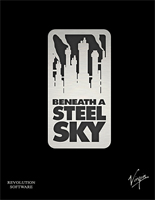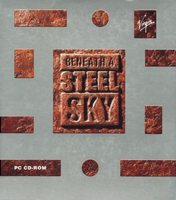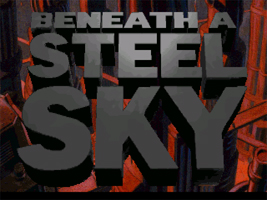


developed by Revolution Software (Hull, England) with Dave Gibbons (St. Albans, England)
first published by Virgin Interactive Entertainment, March 7, 1994 (maybe?), for Amiga/DOS, £34.99
(£34.99 = $59 at 3/94 conversion rate. 1994 $59 = 2015 $94.)
(not sure about the US price but what I’ve found suggests that it was probably $49.95. (=2015 $80))
[current website]
[closest thing to a trailer that existed in 1994]
GOG package ~100MB. Actual game ~70MB. (Original non-talkie version ~8MB.)
Played to completion in 5.5 hours, 4/21/15–4/23/15.
[video: a 3.5-hour complete playthrough that tries to show everything of interest including deaths etc.; or a 2.5-hour playthrough that doesn’t. Both unfortunately use the talkie audio.]More mesmerizing clunkiness from the king of game genres.
1992–3 was probably the peak of my teenage intoxication with computer games, but 1994 wasn’t far behind. Those were years when I compulsively watched the shelves at the stores that carried games, and would eagerly accompany my mom to the mall, at any time, at a moment’s notice, for no other reason than to examine and memorize the current boxes yet again. There are many games that I never actually played that nonetheless loom reasonably large in my imagination because of my ravenous attention to stores and magazine ads in those years. (I have in fact put off playing this game for decades because the mediocre game will surely be of less value to me than my 1992 memories of contemplating the box and hoping against hope that inside was something indescribably immersive.)
So I’ve been well aware of the present game for twenty years: “Sure, Beneath a Steel Sky, British cyberpunk game by the people who later made Broken Sword. Guy in a futuristic suit walking around a futuristic city, escaping from a conspiracy or something. I can picture the box; I can picture the graphics. Supposed to be pretty good. People online call it ‘BASS’. Someday I’ll probably play it.”
Okay, now I did! Another 20-year curiosity brought to ground. That’s really the only news here.
The title screen you see above wasn’t actually part of my experience, because the “CD-ROM version” of the game as provided by GOG has no title screen. It says “Virgin Interactive Entertainment / Revolution / in association with Dave Gibbons PRESENT” … and then the game just begins with no further titles. I guess the game becomes its own signifier. “We present: [this].”
Or more likely it’s a mistake. What I glean (from the surprisingly scanty information available) is that the game was first released on floppy disks without speech and with a physical comic book serving as prologue (in March 1994? Earlier?)… and then some time afterward (in April 1994? Later?) was released for PC CD-ROM with full speech added, and with scans of the comic book incorporated as an onscreen intro, which is the version I played. However, the voice acting is badly done, as such things often were, and I turned it off after half an hour. Everything’s either ridiculously broad or else completely flat and uncomprehending. It sounds exactly like what it is: a marathon session of standing in a booth and plowing through hundreds of pages of disconnected sentences. I can only pity the poor actors who had to do these jobs back when nobody really knew how to produce them.
Here, you can try your own skill — here are three real lines from among the thousands, literally, in the massive non-linear spreadsheet script:
• He was carrying an ID card!
• No — I’m a stranger here.
• Don’t worry — I’ll fix everything.
Good luck coming up with some really compelling, committed, and context-appropriate readings. Understand that given our time constraints, we’re probably going to go with your first take. Also keep in mind that twenty years from now, people will still be playing this game — on their phones, in fact. I know that sentence doesn’t make sense to you yet… but your kids are gonna love it.
Anyway, I downloaded the floppy version to grab a title screen (because my responsibilities to this site demand it), and in retrospect maybe I should have just played that instead of the GOG package. Again. As with Lure of the Temptress, this is a game that Revolution saw fit to set free in 2003. Though interestingly they later found an opportunity to make money with it again, by selling an iOS version starting in 2009. Currently going for $2.99. The mobile market can be ahistorical that way.
As usual, the meaning of the game is mostly implicit in the aesthetic value of the graphics. The backgrounds were drawn by Watchmen artist Dave Gibbons and then converted into that distinctive “scanned-and-processed” style, with its mottled stucco textures: everything looks like it’s been spread as smoothly as possible over rough pixel toast. Somehow, that sandpapery substratum of scanned artwork always makes me particularly attuned to the emotional values of color, which can make a game intensely engaging if it has well-chosen palettes. But the colors in this game are just okay; in nearly every room I had the feeling of a missed opportunity to be more delicious. And I don’t particularly love Dave Gibbons’s draftsmanship, which can feel a little prickly and unstable, including in Watchmen, which I put off reading for years specifically because I found it so unattractive. (Then I finally read it a few years ago. It wasn’t terrible, but it sure is overrated.)
On the other hand, that itchy, un-delicious quality creates a certain synergy with the ominous cyberpunk tone of the story, which is not very elaborate or well written and mostly has to be felt between the lines. This is one of those works where its flaws sort of get subconsciously folded in with its intentions. (I’m thinking of Herk Harvey saying that the shoddiness of Carnival of Souls ended up being essential to its power.) As a piece of craftsmanship, Beneath a Steel Sky is actually a lot iffier than its fans would have you believe, but iffiness can become a kind of seedy noir atmosphere, if you are susceptible. And as I’ve said, one must already be profoundly susceptible if one likes adventure games in the first place.
The adventure gaming here is a very mixed bag. I counted about 90 actions, of which only a few were outrageously stupid — which should be taken as high praise in this genre. But at least a third of them were pretty stupid.
Pacing is actually a more important gauge of entertainment value, I think. 90 divided over 5.5 hours of play comes to an average of 3.7 minutes between successful, game-progressing actions. However my notes actually indicate that toward the beginning of the game, meaningful events came slower, more like one every 5 minutes, and toward the end of the game more like one every 2 minutes. This correlates pretty directly with my impression of the game’s quality, which was that it was really drab at first but then somewhat redeemed itself later on. I think there may be a general principle of narrative game pacing here: I want to feel that I’ve flipped a new card at least once every 3 minutes.
3 minutes feels to me like a good long time to be completely stumped, but not so long that it won’t seem worthwhile in retrospect. I guess this is an answer to my question from some entries ago about how much resistance I want before something gives way. All things being equal — i.e. in an adventure game where the “puzzles” might as well be Mad Libs (use [noun] with [noun]) — it seems like the answer is: about 2-3 minutes of resistance. Less and it hardly qualifies as getting stuck; more and the getting stuck starts to be an event with its own identity, a moment in my life that I might well as negative even after having reached a positive outcome. 2–3 minutes of problem, followed by success: that feels significant but also without any aftertaste of regret.
Of course, internal clocks tick at different speeds depending on one’s mood. If my brain is already on overdrive, I can’t stomach being stuck for even 20 seconds. Sometimes when I’m playing the piano I notice that I am intensely irritated at myself for having to think consciously about what I’m doing for even a tiny fraction of a second — that’s always a sign that it’s time to let go of whatever my goals are in that moment. Contrariwise if I am my most relaxed, slow-pulse, delta-wave self, I feel no angst about being “stuck” on a problem for days or weeks, because I don’t actually see it as “a problem.” But of course to that enlightened self, the only value in an accomplishment is whatever is intrinsic to it; the fact of “overcoming resistance” is not itself meaningful. Which is to say that adventure games would not have much to offer.
Maybe. It’s important for me to keep in mind that when I was a kid and was having my most transporting experiences with computer games, I never finished any of them, and didn’t aspire to. I fantasized about the games a lot, but it was never about winning or overcoming anything. Mostly it was just about what kinds of further wonders might spontaneously emerge from that charmed space.
Beneath a Steel Sky is about the big evil computer that runs the city, which is sci-fi plot number 12. In this case it turns out — Spoiler Sam here, wearing his Spoiler Sombrero! — that it turned evil because it merged with a human. The scientists thought this would be a great way to improve the computer because of how great man is, but actually the computer gained man’s wickedness, his greed and cunning blah blah blah, and became a world-domination monster.
Sci-fi stories are basically all just rigged debates about the relative virtues of the left brain (Spock) and the right brain (Kirk). The “evil computer that runs the city” archetype is an exhibit in the case for the right brain, for the primacy of emotions over cold logic. (See e.g. A Wrinkle In Time.) An “evil computer” story is generally supposed to end with the restoration of warm, emotional, mortal man to the center of the social order where he belongs. But that’s not what happens in Beneath a Steel Sky.
Here we have what I would describe as a neo-nerd inversion of the archetype: actually, the computer’s only evil because it’s not a pure computer, it’s sort of a person after all. In the last areas of the game, it’s seen that the computer has somehow sprouted a huge tangle of icky organic growths, veins and tendrils and whatnot, revealing that we’re not in a sci-fi number 12 after all, we’re actually in a number 7: “organic life is a creepy-crawly nightmare; get out the guns,” which is a case for the left brain, for the necessity of cold steel and no mercy, to keep disgusting flesh from overrunning everything.
The happy ending in this game is that the computer is tricked into giving up its link to humanity and is restored to its proper status as friendly inorganic appliance that, yes, runs everything. This surprise philosophical parity swap felt sad to me, because I got the impression it wasn’t calculated, just arrived at intuitively by the game’s creators, who were still imitating stories made up prior to the rise of computers, but could no longer feel the sense of them. “Cyberpunk,” I see in retrospect, was sort of a generational transition, with cultural fantasies passing uneasily from right to left, learning to love the spooky computers when betrayed by a world of seedy humanity. Maybe now, with stuff like Her (and maybe Ex Machina, which I have yet to see) we’re beginning to undergo the reverse transition — learning to love seedy humanity when betrayed by a world of spooky computers.
To psychoanalyze a bit further — and finish spoiling the game utterly — the actual final scene is sort of ripped off from Return of the Jedi: it turns out that the man brain-plugged into the computer for all these years is the protagonist’s (i.e. your) father, and that the computer has suckered you into this whole adventure of making your way to the inner sanctum so that you, being a blood relative, might replace your father now that he’s dying. When you win the game and escape the computer’s evil tendrils, you get to watch your father die in your arms, begging forgiveness for his error in creating this monster.
The only way I can see of interpreting this (which is to say of feeling it, if I try to feel it): the protagonist’s great victory is meant to be that he breaks the family chain of being all-too-human, and heroically manages to avoid his father’s mistake of letting gross veiny emotions interfere where pure techno-logic should rightly prevail.
That seems unfortunate. The real Return of the Jedi had a much better message: dare to love your dad, even though it might mean submitting to the zappies. But I guess a lot of Star Wars geeks (like the ones who wrote this game) still manage to read it the other way: do better than your dad, resist what he was unable to resist. I think that’s getting it backward.
The script for Return of the Jedi is pretty smart, all things considered. Boy, I really hope Lawrence Kasdan hasn’t gone nervous in his old age like the rest of them.
Anyway, I had an okay time with Beneath a Steel Sky, but I was expecting a lot better based on the game’s reputation. Sure, this was stronger than Lure of the Temptress but that’s not saying much. It’s still just a middling UK also-ran, not at all in the same league as the LucasArts games of the same period in terms of charm, polish, or entertainment value. The animation is probably its strongest suit and there’s only so much of it; the genre setting and some of the story ideas are really a promising match for an adventure game, but that’s all you get; it’s fleshed out with a lot of abrasive “comedy” and moronic digressions. (Give the motorcycle magazine to the motorcycle-loving travel agent in exchange for a tour ticket? This is cyberpunk?)
Your mileage will depend entirely on how willing you are to run with what they give you. I didn’t run, just strolled. Just like the slow-ass protagonist. I’ll be honest, I was usually thinking about other stuff while I played.
Good enough for free. More of the same coming up! Or worse, in fact!
Credits are basically the people who made Lure of the Temptress plus a few more plus Dave Gibbons.
Charles Cecil: director, design, system concept
Daniel Marchant: producer, design, system concept
Dave Cummins: design, writing, music
Dave Gibbons: design, art, background drawings, comic book
Tony Warriner: system concept and design, programming
David Sykes: system concept and design, programming
Les Pace: background paintings
Steve Ince: background paintings, graphics and animation
Tony Williams: music conversion, sound effects
And a few more.